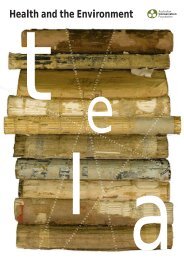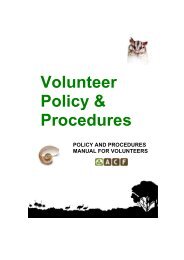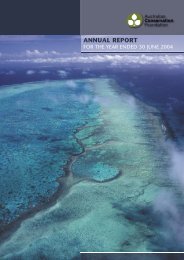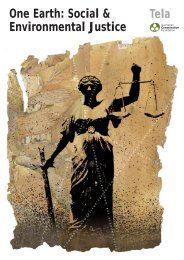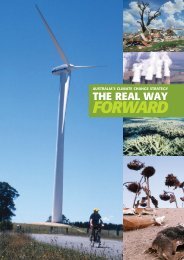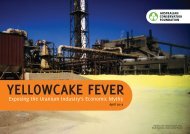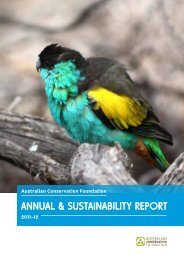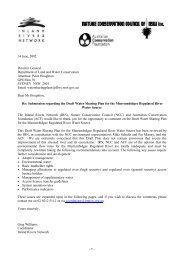Protecting Western Australia's Big Blue Backyard - The Pew ...
Protecting Western Australia's Big Blue Backyard - The Pew ...
Protecting Western Australia's Big Blue Backyard - The Pew ...
- No tags were found...
You also want an ePaper? Increase the reach of your titles
YUMPU automatically turns print PDFs into web optimized ePapers that Google loves.
105 ISLANDS AND A PIRATE<strong>The</strong> Leeuwin Current has lost some of its heatand strength by the time it reaches Esperance,but at 20°C in summer it is still warmer than thesurrounding waters.It is now on its way to the Great Australian <strong>Big</strong>ht,but the islands that were home to Australia’sonly pirate, Black Jack Anderson, are in its path.In the early 19th century Black Jack lived on MiddleIsland in the Recherche Archipelago and attackedpassing ships.<strong>The</strong> warm water and marine life transported bythe Leeuwin Current, and the shelter providedby the many islands and reefs of the RechercheArchipelago, support a wonderful mix of temperateand subtropical species. To the south of theislands, eddies and upwellings attract life to thesurface waters of the upper continental slope andits canyons.<strong>The</strong> archipelago is another significant hotspot formarine life in the region and contains the region’smost extensive area of reef. At the last count therewere at least 263 fish species, 347 mollusc speciesand 242 algae species. Almost 30 per cent of<strong>Western</strong> Australia’s endemic fish are found here,and the archipelago provides important rookeriesfor protected shearwaters and terns and nestingareas for white-bellied sea-eagles.<strong>The</strong> sheltered islands are a great place fortravelling marine animals to rest or breed. Southernright whales calve here and there is a significantAustralian sea lion breeding colony. <strong>The</strong>se sea lionscan only be found in Australia’s southern watersliving on scattered islands.Scientists believe the separate sea lion coloniesstagger their breeding seasons to ensure thereis plenty of food to go around. Australian sealion populations are only slowly recovering fromthe decimation of 19th century sealing. Nowentanglement in fishing nets and competition withfishers for fish are their main threats.When rhodoliths, sponges, bryozoans, barnacles,crabs and seastars die, the calcium carbonate intheir bodies breaks down and forms carbonatesands that blanket the sea floor and help cyclenutrients. Most of the region’s sea floor is coveredby sand which is washed off the shelf, down theslope, into the canyons and then out on to theabyssal plain.<strong>The</strong> shelf that extends to the east of the RechercheArchipelago and across the Great Australian <strong>Big</strong>htis now recognised as the world’s largest area ofcool-water carbonate sediments.<strong>The</strong>se sandy and muddy sediments provide softhabitats for burrowing animals like the giant crab,worms and microscopic animals that live belowthe surface of the sea floor. Little is known of thesecreatures, although it is thought there could bemore than 100 million species worldwide—mostlymicroscopic animals. Many of these animals rely onoxygen trapped between the sand grains and foodthat sinks to the sea floor. In one study, more than800 species were found in just 10 square metres.Scientists suspect that the creatures living in themud and sand of the sea floor could be highlyvulnerable to disturbance. Drilling in a petroleumfield near Portland in Victoria caused the numbersof some species to drop by nearly 90 per cent forseveral months. <strong>The</strong> oil and gas industry is likely toexpand in the Kalbarri to Eucla region.<strong>The</strong> sea floor communities on the continental shelf,shelf break and slope are the foundations of manyfood chains in the region’s marine environment andcritical to its good health. But they are also fragileand in need of strong protection.THE LEEUWIN CURRENT’S LONGAND IMPORTANT JOURNEYAfter the Recherche Archipelago the LeeuwinCurrent leaves the Kalbarri to Eucla region andcontinues east across the Great Australian <strong>Big</strong>htto its end on the west coast of Tasmania.On its long and important journey through<strong>Western</strong> Australia’s big blue backyard, theLeeuwin current connects and influences themarine life and people of the region. <strong>The</strong> currentis integral to the global uniqueness of the Kalbarrito Eucla region’s marine life.<strong>The</strong> Leeuwin Current brings the region clear,warm and low-salinity water and mixes theeggs and larvae of tropical marine life withsubtropical and temperate species. It passes themost southerly tropical coral reefs in the IndianOcean, internationally significant inshore lagoons,the largest Australian canyon, the deepestpoint in Australia’s oceans, the nation’s highestunderwater mountain range and the feeding areaof the world’s largest and one of the world’s rarestanimals.It also witnesses many of the threats now facingthe region’s marine environment includingoverfishing, bycatch, coastal development andwater pollution and is itself under threat fromclimate change.People living along the Kalbarri to Eucla coasthave developed a strong connection with andreliance on the region’s marine environment.<strong>The</strong>ir futures are inextricably linked.<strong>The</strong> western wobbegong is unique to<strong>Western</strong> Australia. Seven of the world’sten wobbegong species are found in thewaters off south-west Australia© marinethemes.com / Ray DelamareRecently a team of scientists found 450 species ofsponges, extensive beds of rhodoliths (corallinealgae) and a wide range of soft corals in theRecherche Archipelago. <strong>The</strong> discovery of therhodoliths was a first for the area and some havebeen dated at 720 years of age.Rhodoliths are free-living algae that secrete acoralline skeleton, sometimes resemble golf ballsand can grow up to five centimetres across. Withsponges and soft corals they provide shelter,nursery and feeding areas for marine spiders,snails, worms and juvenile scallops. <strong>The</strong>y are rare inAustralia and highly vulnerable to bottom trawling.52



